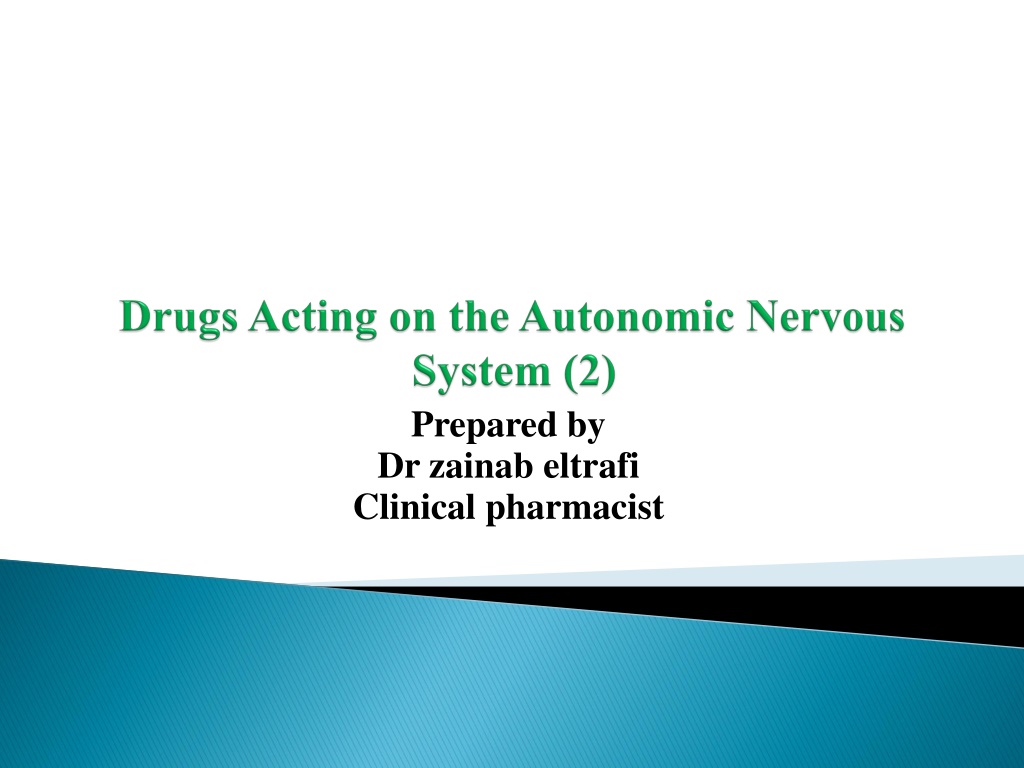Understanding Adrenergic Agonists and Their Classification
Sympathomimetic amines like epinephrine, norepinephrine, isoproterenol, and dopamine are catecholamines with high potency but poor CNS penetration. Noncatecholamines like phenylephrine and ephedrine have longer half-lives. Learn about direct-acting, indirect-acting, and mixed-action adrenergic agonists, including their cardiovascular, respiratory, and hyperglycemic effects.
Download Presentation

Please find below an Image/Link to download the presentation.
The content on the website is provided AS IS for your information and personal use only. It may not be sold, licensed, or shared on other websites without obtaining consent from the author. Download presentation by click this link. If you encounter any issues during the download, it is possible that the publisher has removed the file from their server.
E N D
Presentation Transcript
Prepared by Dr zainab eltrafi Clinical pharmacist
Sympathomimetic amines that contain the 3,4-dihydroxybenzene group (such as epinephrine, norepinephrine, isoproterenol, and dopamine) are called catecholamines. These compounds share the following properties: High potency Rapid inactivation: Poor penetration into the CNS because they are polar
Catecholamines Noncatecholamines
Compounds lacking the catechol hydroxyl groups have longer half-lives, because they are not inactivated by COMT. These include phenylephrine, ephedrine, and amphetamine These are poor substrates for MAO and, thus, show a prolonged duration of action, because MAO is an important route of detoxification. Increased lipid solubility of many of the noncatecholamines (due to lack of polar hydroxyl groups) permits greater access to the CNS.
Classification of the adrenergic agonists Direct-acting agonists: Include: epinephrine, norepinephrine, isoproterenol, and phenylephrine. Indirect-acting agonists: Include amphetamine, cocaine and tyramine. Mixed-action agonists: Include ephedrine, pseudoephedrine and metaraminol, may act directly to stimulate adrenoceptors and indirectly to release norepinephrine from the adrenergic neuron
A. Epinephrine Is a catecholamine. Interacts with both and receptors. At low doses, effects (vasodilatation) predominate, whereas at high doses, effects (vasoconstriction) are strongest.
a. Cardiovascular: Epinephrine strengthens the contractility of the myocardium (positive inotropic: 1 action) and increases the heart rate (positive chronotropic: 1 action). Epinephrine increases systolic blood pressure, coupled with a slight decrease in diastolic pressure..
B. Respiratory: Epinephrine causes powerful bronchodilation ( 2 action). Epinephrine inhibits the release of allergy mediators such as histamines from mast cells. c. Hyperglycemia : Epinephrine has a significant hyperglycemic effect because of increased glycogenolysis in the liver ( 2 effect), increased release of glucagon ( 2 effect), and a decreased release of insulin ( 2 effect).
Lipolysis: Epinephrine initiates lipolysis through its agonist activity on the receptors of adipose tissue Lipolysis:
Treatment of acute asthma and anaphylactic shock, epinephrine is the drug of choice;. Glaucoma: in open-angle glaucoma. It reduces the production of aqueous humor. Cardiac arrest: Epinephrine may be used to restore cardiac rhythm. Anesthetics: Local anesthetic solutions usually contain 1:100,000 parts epinephrine. The effect of the drug is to greatly increase the duration of the local anesthesia. It does this by producing vasoconstriction at the site of injection.
Adrenaline is destroyed by a stomach acid is therefore not effective if taken orally. It usually given by SC or IM injection
CNS disturbances: include anxiety, fear, tension, headache, and tremor. Cerebral hemorrhage: as a result of a marked elevation of blood pressure. Cardiac arrhythmias Pulmonary edema.
Cardiovascular actions: Vasoconstriction: Both systolic and diastolic blood pressures increase Norepinephrine is used to treat shock, because it increases vascular resistance and, therefore, increases blood pressure. However, metaraminol is favored.
Dopamine the immediate metabolic precursor of norepinephrine, occurs naturally in the CNS in the basal ganglia, where it functions as a neurotransmitter, as well as in the adrenal medulla. Dopamine can activate - and -adrenergic receptors. For example, at higher doses, it can cause vasoconstriction by activating 1 receptors, whereas at lower doses, it stimulates 1 cardiac receptors. In addition, D1 and D2 dopaminergic receptors, distinct from the - and -adrenergic receptors, occur in the peripheral mesenteric and renal vascular beds, where binding of dopamine produces vasodilation. D2 receptors are also found on presynaptic adrenergic neurons, where their activation interferes with norepinephrine release.
Dopamine is the drug of choice for cardiogenic and septic shock and is given by continuous infusion. It raises the blood pressure by stimulating the 1 receptors on the heart to increase cardiac output and 1 receptors on blood vessels to increase total peripheral resistance. In addition, it enhances perfusion to the kidney and splanchnic areas It is also used to treat hypotension and severe congestive heart failure, primarily in patients with low or normal peripheral vascular resistance and in patients that have oliguria.
Isoproterenol is a direct-acting synthetic catecholamine that predominantly stimulates both 1- and 2-adrenergic receptors Therapeutic uses: It can be employed to stimulate the heart in emergency situations.
Dobutamine is a synthetic, selective 1 agonist. Dobutamine is used to increase cardiac output in congestive heart failure.
The drug is an agonist at 2 receptors, producing little effect on 1 receptors of the heart. The drug is useful as a bronchodilator in the treatment of asthma Albuterol, pirbuterol, and terbutaline short-acting 2 agonists used primarily as bronchodilators .
Salmeterol and formoterol are selective 2-agonists, long-acting bronchodilators. These agents are highly efficacious when combined with a corticorsteroid
They potentiate the effects of norepinephrine produced endogenously, but these agents do not directly affect postsynaptic receptors.
A. Amphetamine Amphetamine A. Central stimulant, abused drug - Its peripheral actions are mediated primarily through the release of stored norepinephrine and the blockade of norepinephrine uptake. -
B. Tyramine not a clinically useful drug, but it is important because it is found in fermented foods, such as cheese. C. Cocaine is a local anesthetic (sodium channel blocker) and is a CNS stimulant (blocks the reuptake of norepinephrine, thus potentiating NA effects). C. Cocaine























